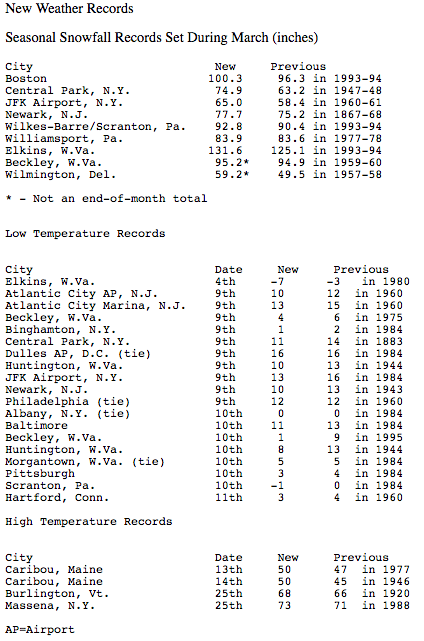March averaged 7 degrees colder than the same month last year
By Blaine Friedlander
March averaged 7 degrees colder than the same month last year, as the Northeast officially endured the 18th coldest March in 102 years of record, according to the Northeast Regional Climate Center at Cornell University.
"The Northeast couldn't break the grip of winter during March 1996," said Keith Eggleston, regional climatologist at the center. Cold weather plagued the 12-state region, as the monthly average temperature was 4.1 degrees colder than normal -- the coldest March in the Northeast since 1984. Maine had the smallest departure from normal at minus-2.2 degrees. West Virginia reported the largest departure at minus-5.8 degrees, making this the 10th coldest March on record there.
Along with the cold came more snow. Monthly snowfall totals were above normal everywhere except the extreme northern portion of the region. Erie, Pa., tripled its normal March snowfall with a total of 31.8 inches for the month. Charleston, W.Va., padded what was already a seasonal snowfall record with another 20.4 inches (four times the normal) during March. Meanwhile, Caribou, Maine, reported 2.8 inches below normal for the month and Burlington, Vt., was 1.5 inches below their monthly normal.
Northeastern cities that during March surpassed their previous record snowiest seasons included Elkins and Beckley, W. Va.; Wilmington, Del.; Wilkes-Barre/Scranton and Williamsport, Pa.; Newark, N.J., Boston; and New York City (Central Park and JFK Airport). By mid-April this list grew to include Binghamton, N.Y., Concord, N.H., Bridgeport, Conn., and Worcester, Mass.
"Despite the excessive amounts of snow, March had less than the expected amount of precipitation (rain and water content of snow)," Eggleston said. The region overall measured 81 percent of the normal March precipitation, ranking it the 24th driest March on record. Pennsylvania (105 percent) and West Virginia (101 percent) were the only states to report slight excesses. Vermont and Connecticut were the driest states with respect to normal, with 55 percent of the 30-year average each.
Media Contact
Get Cornell news delivered right to your inbox.
Subscribe